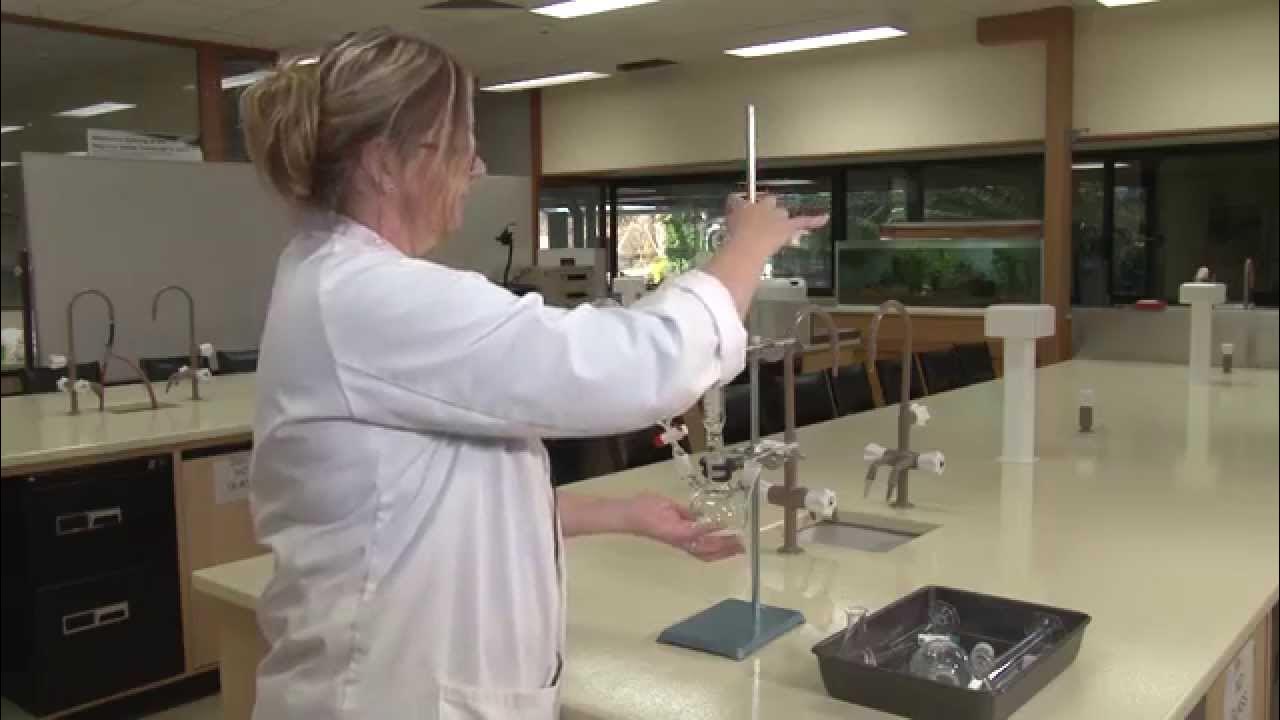How to make Butyric Acid (Grignard Reaction)
Summary
TLDRThis video details the process of synthesizing butyric acid via a Grignard reaction, starting with the formation of a Grignard reagent by reacting magnesium with bromopropane in dry ether. The process involves careful control of water sensitivity, the addition of CO2 to the reaction mixture, and hydrolysis with hydrochloric acid. Key steps include vacuum filtration, multiple washes with water and sodium hydroxide, and reacidification to isolate the final product. Despite minor impurities, such as a pink coloration, the process yields butyric acid, with an NMR confirming the purity of the final compound.
Takeaways
- 😀 The Grignard reaction is useful for forming carbon-carbon bonds but is highly sensitive to moisture.
- 😀 Even small amounts of water can ruin the Grignard reaction, so care must be taken to avoid contamination.
- 😀 The setup includes an oven-dried three-necked round-bottom flask, magnesium, dry ether, and a condenser to prevent moisture exposure.
- 😀 The reaction starts when bromopropane is added slowly to the magnesium-ether solution, initiating the formation of the Grignard reagent.
- 😀 Adding iodine crystals can help trigger the reaction if it doesn't start spontaneously.
- 😀 The reaction is exothermic, causing ether to boil, which is why a condenser is necessary to control the heat.
- 😀 Carbon dioxide is bubbled through the solution after the Grignard reagent is formed, resulting in a thicker solution as CO2 reacts.
- 😀 Replenishing ether during the reaction is important as it evaporates with the loss of CO2 and during the reflux process.
- 😀 The reaction mixture is washed with hydrochloric acid to induce hydrolysis, converting the Grignard reagent into butyric acid.
- 😀 After hydrolysis, the solution is vacuum-filtered to remove unreacted magnesium, and the ether layer is separated to isolate the product.
- 😀 The product is purified through multiple washes with water and sodium hydroxide to neutralize any excess acid and ensure proper isolation of butyric acid.
- 😀 The ether layer is dried using sodium sulfate and evaporated using a simple evaporation method to avoid odors from a rotovap.
- 😀 Despite some contamination (e.g., pink color), the final butyric acid product was found to be clean based on NMR results.
Q & A
What is the main disadvantage of the Grignard reaction described in the transcript?
-The main disadvantage of the Grignard reaction is its high sensitivity to moisture. Even a small amount of water can ruin the reaction.
Why is a drying tube used in the apparatus setup for this reaction?
-A drying tube is used to protect the reaction from exposure to atmospheric moisture, ensuring that the Grignard reagent remains stable and unreacted with water.
What role does iodine play in the Grignard reaction described in the script?
-Iodine is added to the reaction to initiate the formation of the Grignard reagent. It helps trigger the reaction when added to the magnesium and bromopropane mixture.
Why is it necessary to maintain the temperature of the ether solution during the reaction?
-The reaction between magnesium and bromopropane is highly exothermic, causing the ether to boil. Maintaining a constant temperature is important to prevent the ether from evaporating too quickly.
What happens to the ether solution as the reaction proceeds?
-As the reaction progresses, the ether begins to boil and reflux. The solution also turns black due to the formation of the Grignard reagent.
What is the purpose of bubbling CO₂ through the reaction mixture?
-Bubbling CO₂ through the reaction mixture reacts with the Grignard reagent to form butyric acid, the desired product of the reaction.
Why is it important to add more ether during the reaction process?
-More ether is added throughout the reaction to maintain a constant volume, as ether is lost due to evaporation during the exothermic reaction.
How is the butyric acid product isolated after the CO₂ bubbling?
-The product is isolated by washing the reaction mixture with hydrochloric acid, followed by multiple ether extractions, neutralization with sodium hydroxide, and drying the ether layer.
What does the pink color in the final product indicate?
-The pink color in the final product suggests contamination, though an NMR analysis confirms that the product is relatively clean despite this coloration.
Why is sodium sulfate used during the work-up of the reaction?
-Sodium sulfate is used to dry the ether layer, removing any residual water before the solvent is evaporated to isolate the product.
Outlines

Dieser Bereich ist nur für Premium-Benutzer verfügbar. Bitte führen Sie ein Upgrade durch, um auf diesen Abschnitt zuzugreifen.
Upgrade durchführenMindmap

Dieser Bereich ist nur für Premium-Benutzer verfügbar. Bitte führen Sie ein Upgrade durch, um auf diesen Abschnitt zuzugreifen.
Upgrade durchführenKeywords

Dieser Bereich ist nur für Premium-Benutzer verfügbar. Bitte führen Sie ein Upgrade durch, um auf diesen Abschnitt zuzugreifen.
Upgrade durchführenHighlights

Dieser Bereich ist nur für Premium-Benutzer verfügbar. Bitte führen Sie ein Upgrade durch, um auf diesen Abschnitt zuzugreifen.
Upgrade durchführenTranscripts

Dieser Bereich ist nur für Premium-Benutzer verfügbar. Bitte führen Sie ein Upgrade durch, um auf diesen Abschnitt zuzugreifen.
Upgrade durchführen5.0 / 5 (0 votes)






